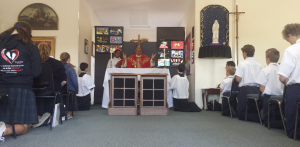Catholic Classical Education at St. Augustine Academy
Catholic Culture
Article from Institute for Catholic Liberal Education
…Culture is inseparable from education, since education in the widest sense of the word is what the anthropologists term “enculturation,” i.e., the process by which culture is handed on by the society and acquired by the individual. Christopher Dawson, Crisis of Western Education

Fr. Passos celebrating Mass with the students
Catholic education culminates in handing on the rich Catholic treasury of thought and beauty. The development of the student’s powers of thought, expression, imagination and wonder prepares him to receive and appreciate his cultural birthright.
Over 2000 years, the Catholic Church has encountered a dizzying variety of religions, philosophies, political systems, fine art, architecture, literature. According to the Incarnational principle, she has discerned the good from the evil in each case, absorbing and transforming what is worthy. The Church has used these talents to develop the deposit of faith received from her Lord, Jesus Christ.
As Pope Benedict has indicated, Providence chose the Hellenistic civilization as the first home for the coming of the Incarnate Word and the early growth of the Church. Schools today are right to introduce their students to the best in non-Western cultures. Yet, the central importance of Greco-Roman culture to Christianithy must not be lost.
In the light of our experience with cultural pluralism, it is often said nowadays that the synthesis with Hellenism achieved in the early Church was apreliminary inculturation which ought not to be binding on other cultures. The latter are said to have the right to return to the simple message of the New Testament prior to that inculturation, in order to inculturate it anew in their own particular milieux. This thesis is not only false; it is coarse and lacking in precision. The New Testament was written in Greek and bears the imprint of the Greek spirit, which had already come to maturity as the Old Testament developed.
(Benedict XVI, Lecture at the University of Regensburg, Sept. 2006.)
Catholic classical educational schools hand on to their students what they have received – the great stories of History and Literature, the beauty of the Fine Arts, the wisdom of Philosophy and Theology.
Why read Classical Literature
Mike Van Hecke -Headmaster and President of the Institute for Catholic Liberal Education
tired. And yet, even on most of those nights we made sure to read at least one chapter of the story we were enjoying.On the far side of this exercise, we have seen the powerful and lovely benefits of this practice. Our lives, and the lives of our children are much richer for the friends we met (Tom Sawyer, Bilbo Baggins and Alice and the Cheshire Cat), the places we visited (Dickens’ London, Dante’s Inferno, and the raccoon’s den where we wait till the moon is full), and the things we saw (trolls, cows jumping over the moon and Pa swinging his ax.) Goodnight Moon!
I shared before the great benefits of reading aloud to the children – it should be a high priority for young children, and a priority which may re-arrange but not disappear even for older children. One suggestion I read for Lent was to decrease “electricity time.” Spend LESS time with TV, radio or the computer…especially the internet where much time is truly wasted in social surfing and Enquirer-like news sites.


